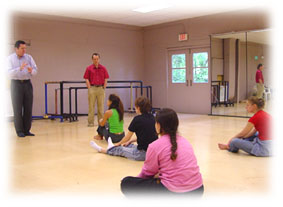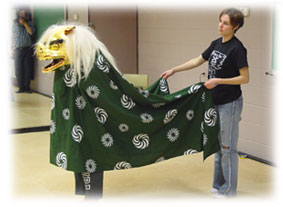
If you ask Catawba College Theatre Arts Professor Woody Hood to describe elements involved in the Japanese Lion Dance, here’s what he’ll tell you: “The dance depicts an afternoon in the life of a lion where he runs around, cleans himself, eats fleas off of himself, eats some fruit, takes a nap, chases a butterfly, and then runs around some more.”
What he doesn’t tell you is just how difficult the dance is to perform while the dancer operates a $4,000 hand-carved gilt Japanese lion mask from beneath an attached costume curtain. That awareness, however, is exceedingly clear to five students enrolled in the course, Japanese Musical Theatre, that Hood and Dr. David Fish, a professor of music, are team-teaching this semester.
Students in the class include Shea Walker of Salisbury, Elizabeth Simpson of Loveland, Ohio, Danielle Papet of Glassboro, N.J., Briana Raymond of Spring Hill, Fla., and Kathryn Shanklin of Houston, Texas.
 ;
;
One aspect of this course requires that the five students each learn to perform the Japanese Lion Dance. Not native to Japan, lions often receive a magical or fantastical depiction in Japanese arts. The mythical lion or shishi was introduced to Japan from continental Asia during the fifth and sixth centuries. It developed into a traditional offering performed at Shinto festivals across Japan. Door-to-door lion-dance troupes were also a common sight during the New Year season. While the energetic, frolicking nature of the dance may be most apparent; it was primarily performed to spread the protective power of a shrine’s tutelary deity.
To this end, these students have been watching videos of Japanese dancers executing this dance and practicing their own techniques as their classmates and professors coach them along, prompting them on their steps and motions. They even have an official performance date for the dance slated Saturday, May 7 during the International Festival scheduled in Lexington.
 ;
;
Dancing Like a Japanese Lion
Many varieties of the shishi dance are found across Japan. The version being learned by students at Catawba is a special form transmitted by the Wakayama guild of Tokyo, one of Japan’s Important Intangible Cultural Assets. Fish learned the dance from the guild’s leader, Wakayama Taneo, while conducting dissertation fieldwork during the late 1980s. Fish is currently teaching several Catawba music students the drum parts that accompany the dance, which he also studied under Wakayama. If all goes according to plan, the musicians will also make their debut at the Lexington festival.
On a recent class day, the students rehearsed in Catawba’s dance studio, each wearing traditional Japanese socks. The session begins with their questions: “How do you hold it (the mask) with one hand?” How do you keep the (costume) curtain from getting underneath you?
Fish and Hood answer them patiently and then give them advice as they each go through the motions of the dance. The students practice their technique one by one while their classmates sit on the floor watching and collectively calling out the next of the actions in the dance sequence.
“And left and shake and now right and shake, and turn and run around,” the students say in unison.
“The faster you get going, the faster the curtain will fall behind you and the farther out from your feet it will be,” Fish says, urging the student to quicken their pace.
“If you hear the (lion’s) ears rattle, you’re doing it right,” Fish continues.
“Flat to the floor, Danielle,” Hood admonishes, as a student assumes a difficult position which makes the lion appear to be gnawing at its back.
“And, paku,” Fish adds, indicating that the student should manipulate the lion mask so that it appears to chomp.
On this day, the five students practice several additional sequences in this traditional dance, including one part where the lion takes a piece of fruit or mekon into its mouth. They go through the motions without the mask, concerned about both the sequencing of the dance and the techniques they use to depict the moves of the animal.
For these novices, there is no room for personal interpretation in the Japanese Lion Dance, Hood explains, there’s just a correct or traditional way to do it. As dancers become more experienced in the dance, then they add their personal nuances.
Soon, the students will add traditional Japanese music to their choreography, but the music will not cue them as if often does in Western dance about which step to begin or end. “The music and dance in this run parallel,” Hood says. “They are associated but not directly correlated.”
Next Stop, Tokyo
When classes and exams conclude, four of the five students in this class will travel to Tokyo to experience Japanese culture first-hand. Although they won’t be performing their Japanese Lion Dance, chances are they’ll be able to catch a performance of it while there.
